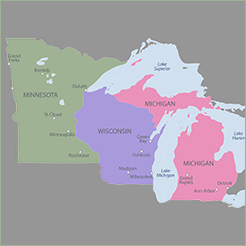Forest Industry Challenges and Initiatives in the Lake States Region

FRA reached out to associations across the Lake States Region and asked them to provide information about what keeps them up at night in terms of the challenges and initiatives of the forest products industry. In this blog, Minnesota Forest Industries, the Minnesota Timber Producers Association, the Great Lakes Timber Professionals Association, and the Michigan Association of Timberman provide an overview from their respective views.
Minnesota Forest Industries and Minnesota Timber Producers Association
Climate Change
In September 2020, Minnesota Governor Tim Walz convened an Advisory Council on Climate Change, charged to work with the governor’s Climate Change Subcabinet to “identify innovative policies and strategies to reduce greenhouse gas emissions and increase climate resiliency.”
Minnesota Timber Producers Association Executive Vice President Mike Birkeland is among the 15 appointed to the governor’s Advisory Council, so our industry will have a seat at the table and a voice in the discussion. Other advisory council members include representatives of conservation groups, environmental organizations, tribal government, agriculture groups, organized labor, energy providers, academia, and more.
The good news is that many advisory council members already understand the role our forests play in mitigating climate change. Trees absorb carbon. However, many do not yet understand that trees can be harvested and turned into products that store carbon, and allowing forests to be renewed before they die, decay, or burn up, producing harmful carbon emissions.
Through the governor’s Advisory Council, we will continue to make the points we have been making for years:
- Forest products store carbon for the long-term – growing and harvesting trees is an important investment in the health of our forests.
- Active forest management and forest products are our greatest natural solutions to combat climate change. We need policies (and funding) that support active forest management and regeneration of our forests.
- Forestlands remove 14% of the nation’s annual carbon emissions as they grow.
- In Minnesota, forests also remove 14% of C02 emissions in the state and store the equivalent of 50 years of all CO2 emissions produced.
- Young trees sequester carbon as they grow, and forest products store carbon for the long-term – sometimes hundreds of years.
We will also continue to make these points with state lawmakers and agency personnel around the state.
Markets
In June 2020, Verso Paper announced the closure of its Duluth mill. In addition to the 240 jobs lost at the mill, timber markets for loggers throughout the state were adversely affected. Not only did the mill’s logging contractors lose their markets for species like spruce and balsam fir, but markets for those species at other mills significantly tightened. In addition, some spruce and balsam fir loggers shifted their focus to aspen, affecting markets for those species as well. Most every logger in Minnesota was affected by the mill closure in some fashion.
In February, bills were introduced in the state Senate and House of Representatives to provide relief to holders of Minnesota Department of Natural Resources timber permits. If passed, the provision would allow for the opportunity to get the permits extended, or down payments refunded. Last year, the county boards in St. Louis, Itasca, and Koochiching Counties offered various forms of relief to holders of county forest timber permits due to loss of markets.
Ray Higgins, Vice President for Operations, Minnesota Timber Producers Association and Minnesota Forest Industries.
Great Lakes Timber Professionals Association
Michigan, Wisconsin, and Minnesota are seeing the impacts and realities of major wood consumers shuttering operations for an extended period. With approximately two million tons of market gone for the immediate future, landowners, loggers, and mill employees are left to find other opportunities to fill the gap.
One such opportunity is a potential multi-stakeholder cooperative form of mill ownership that, to the best of our knowledge, has not been done in the U.S. Cooperatives themselves are nothing new, and they typically involve one class of ownership. A multi-stakeholder cooperative includes two or more class types of ownership and is a combination of cooperatives. For instance, one cooperative may be loggers and truckers, while another might include landowners and another for mill workers. When combined for a common cause, these cooperatives form the multi-stakeholder group, with each having equal seats at the table.
What is the advantage? Multi-stakeholder cooperatives utilize long-term thinking for ownership and are not focused solely on profitability. Profit is mandatory for any business; however, the main goal for a cooperative is the longevity of business operations for members. There is no denying that many U.S. businesses in recent years have seen short-term investment plans where they are bought, made profitable, and sold off to other investors who will do the same. These plans rarely include capital investment for the long haul or adequate investment for research and development for the production of new product lines. If long-term thinking and planning were implemented, the rate of mill closures should be expectedly less than what is being witnessed.
For the benefit of forest health, it is imperative adequate and reliable markets are available for the consumption of growing timber in the Lake States Region. As seen in other parts of the U.S., when manufacturing infrastructure disappears, forest health degrades rapidly, taking decades to rebuild. The utilization of multi-stakeholder cooperatives is a realistic alternative, and efforts to bring the first multi-stakeholder cooperative acquisition to fruition are ongoing.
While the storms that occurred in mid-summer 2019 devastated thousands of acres of timberland, they also brought the opportunity to explore efficiencies in timber transportation and utilization of electronic means to implement and honor boundaries between owners of forestlands. Using GIS and other systems eliminates foresters being placed in harm’s way while crawling through damaged timber to place boundaries. It also reduces costs and increases cleanup speed. Hopefully, information gathered during these emergency situations will provide an impetus for future implementation of efficiencies and cost savings.
Great Lakes Timber Professionals Association (GLTPA) is a 501(c)6 non-profit organization that represents loggers, truckers, sawmills, paper manufacturers, private and commercial forest landowners, forestry professionals, school districts, and outdoor recreation enthusiasts in Michigan and Wisconsin. GLTPA’s mission is to “Enhancing a Multiple-Use Forest for Future Generations.”
Henry Schienebeck, Director, GLTPA
Michigan Association of Timbermen
The Michigan Association of Timbermen (MAT) was founded in 1972 to serve the interests of the forest products industry. As a steward of Michigan’s forest resources, contributions from our association members provide us the opportunity to address important issues such as the log plate, road funding, multiple-use permits for moving equipment, fee-free driveway permits, and protecting the forest fund.
Based on various discussions with MAT members, challenge items for 2021 include the following:
- Increase demand for forest products. Members expressed concern regarding the closures of the Wisconsin Rapids and Duluth pulp mills, thus increasing pulpwood deliveries to the two Verso pulp mills in Upper Michigan. Hardwood markets are improving, and there needs to be an increase in demand in overseas markets for hardwood lumber and veneer products.
- Fuel prices. Oil prices per barrel have increased 20%+ since January. This increase has resulted in rising prices at the pump. Transportation is an important vector and increasing fuel prices will increase the costs of transportation.
- Labor shortages in the forest product industry. Labor shortages are being realized in transportation (drivers), equipment operators, mechanics, mill workers, and general logging operation woods workers. There is a need for more worker training in these various career opportunities and sectors of the forest products economy. The pay and benefits appear to be competitive, but very few people want to fill these positions.
- Increases in regulations and permits which affect our industry. This includes environmental permits on logging operations, to truck hauling permits, and weight limitations on various roadways that can be different from state forest, federal forest, county, or township.
The Michigan Association of Timbermen is committed to the practice of sustainable forestry to meet the needs of the present without compromising the ability of future generations to meet their own needs.
We work to acquire greater exposure and understanding of the issues and untapped economic potential of Michigan’s Forest Industry. It is our mission to operate programs that reduce operating costs, therefore improving the profitability of our member firms.
Michelle Sears, Administrator, Michigan Association of Timbermen
Glen Tolksdorf, Board Member, Michigan Association of Timbermen


